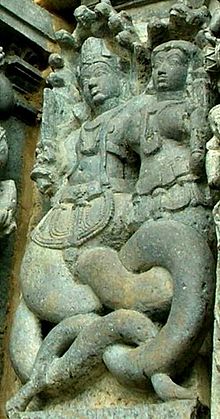
A | B | C | D | E | F | G | H | CH | I | J | K | L | M | N | O | P | Q | R | S | T | U | V | W | X | Y | Z | 0 | 1 | 2 | 3 | 4 | 5 | 6 | 7 | 8 | 9
| Naga | |
|---|---|
 A Naga couple, featured as a Hoysala relief | |
| Devanagari | नाग |
| Venerated in | Hinduism, Buddhism, Jainism |
| Abode | Patala |
| Texts | Mahabharata, Puranas |
In various Asian religious traditions, the Nagas (Sanskrit: नाग, romanized: Nāga)[1] are a divine, or semi-divine, race of half-human, half-serpent beings that reside in the netherworld (Patala), and can occasionally take human or part-human form, or are so depicted in art. A female naga is called a Nagi, or a Nagini. Their descendents are known as Nagavanshi. According to legend, they are the children of the sage Kashyapa and Kadru. Rituals devoted to these supernatural beings have been taking place throughout South Asia for at least 2,000 years.[2] They are principally depicted in three forms: as entirely human with snakes on the heads and necks, as common serpents, or as half-human, half-snake beings in Hinduism, Buddhism, and Jainism.[3]
Nagaraja is the title given to the king of the nagas.[4] Narratives of these beings hold cultural significance in the mythological traditions of many South Asian and Southeast Asian cultures, and within Hinduism and Buddhism. Communities such as the Nagavanshi, Khmer and Eelamese claim descent from this race.
Etymology
In Sanskrit, a nāgá (नाग) is a snake, most often depicted by the Indian cobra (Naga Raja). A synonym for nāgá is phaṇin (फणिन्). There are several words for "snake" in general, and one of the very commonly used ones is sarpá (सर्प). Sometimes the word nāgá is also used generically to mean "snake".[5] The word is cognate with English 'snake', Germanic: *snēk-a-, Proto-IE: *(s)nēg-o- (with s-mobile).[6]
Alternatively, an Indo-European etymology as a "hairless, naked animal" - cognate to English "naked" - would explain that the Sanskrit word nāga can also mean "cloud", "mountain" or "elephant".[7]
Hinduism

Nagas, as a serpent-shaped group of deities that often take form as cobras, are prominent in Hindu iconography, throughout the mythology (especially in the first book of the Mahābhārata) and in local folk traditions of worship.[8] In some regions of the Himalaya, nagas are regarded as the divine rulers of the region - as in Kullu Valley, in Berinag and in the valley of the Pindar River, which is believed to be ruled by the ninefold Naiṇī Devī. Both in the Nilamata Purana of Kashmir and in the Swayambhu Purana of Kathmandu, the respective region begins its history as a lake, populated by nagas, which is later drained.[9]
Mythological Sanskrit texts such as the Mahabharata, the Ramayana, and the Puranas describe the nagas as a powerful, splendid and proud semi-divine species that can assume their physical form either as human (often with a halo of cobra hoods behind their head), as a partially human serpent, or as a whole serpent. Their domain is in the enchanted underworld, the underground realm filled with gems, gold and other earthly treasures called Naga-loka or Patala-loka. They are also often associated with bodies of waters — including rivers, lakes, seas, and wells — and are guardians of treasure.[10] Their power and venom make them potentially dangerous to humans. However, in Hindu mythology, they often take the role of benevolent protagonists; in the Samudra Manthana, Vasuki, a nagaraja who abides on Shiva's neck, became the churning rope for churning of the Ocean of Milk.[11] Their eternal archrival is the Garuḍa, the legendary semi-divine bird-like deity.[12]
Vishnu is originally portrayed in the form sheltered by Sheshanāga or reclining on Shesha, but the iconography has been extended to other deities as well. The serpent is a common feature in Ganesha iconography, and appears in many forms: around the neck,[13] use as a sacred thread (Sanskrit: yajñyopavīta)[14] wrapped around the stomach as a belt, held in a hand, coiled at the ankles, or as a throne.[15] Shiva is often shown garlanded with a snake.[16] Maehle (2006: p. 297) states that "Patanjali is thought to be a manifestation of the serpent of eternity".
| Part of a series on |
| Hinduism |
|---|
 |
